
Heath Haussamen / New Mexico In Depth
In areas where the 2013 Silver Fire burned hottest, such as this spot off Royal John Mine Road in the Black Range in the Gila National Forest, it decimated plant life.EMORY PASS, GILA NATIONAL FOREST – The sun illuminates patches of green on brown and black hillsides around Highway 152 near Emory Pass in the Gila National Forest.
Gambel oak and other shrubs whose roots survived a lightning-sparked wildfire in 2013 sprout on many slopes once dominated by ponderosa pines. Black, mangled masses of wood and dead barley plants loom over the new growth, which also includes aspens, grass and wildflowers. The barley grew last fall from seeds the U.S. Forest Service dropped to minimize erosion after the Silver Fire.
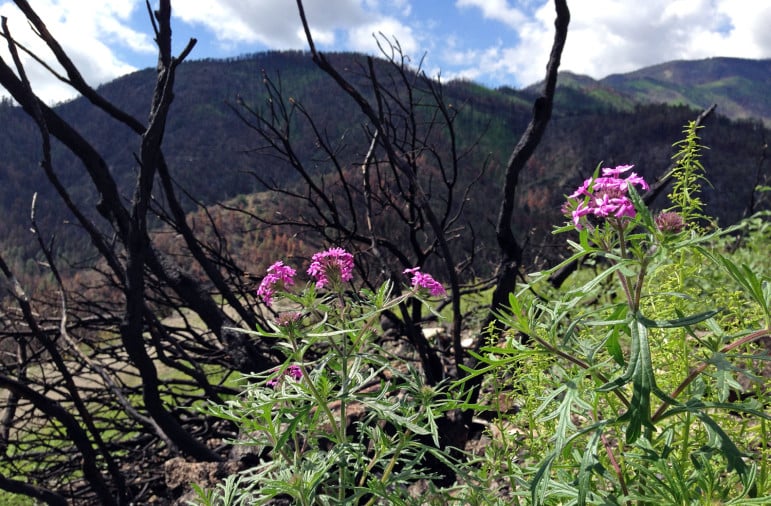
Heath Haussamen / New Mexico In Depth
New life began sprouting soon after the Silver Fire. This photo was taken in the fall of 2013 along Highway 152 west of Kingston.Pines survived in many areas within the 139,000-acre burn scar. But in other places, the trees were incinerated – and in the most heavily torched areas, new pines aren’t sprouting.
Though New Mexico hasn’t seen a similarly large fire this year due in part to recent rains that have pushed parts of the state out of drought, such blazes have become commonplace here. With so many coniferous trees dying – including ponderosa pines and the official state tree, the piñon – forests in Southern New Mexico, Northern New Mexico and beyond are transforming into new ecosystems people living today haven’t seen before.
Credit human-caused overgrowth in our forests, along with drought and the planet’s warming climate, for the shift. In the desert Southwest, an immense amount of tinder sits on top of a drier landscape in a climate that’s warmer than at any time in the past 1,000 years, scientists believe.
“We can’t stop the fires. We can’t stop the forests from thinning themselves out, because there’s just not enough water to support this biomass,” says Craig Allen. Since the 1980s, the U.S. Geological Survey research ecologist has studied the history of landscapes in the Southwest and how climate change is affecting them.
It’s possible that, in the future, more mountain ranges across the Southwest will look like America’s newest national monument, the Organ Mountains-Desert Peaks monument in Doña Ana County, Allen says.
Some ponderosa pines and piñon grow in the Organs, particularly around water sources. But more drought-tolerant shrubs and grasses cover much of the Organs and other peaks in the national monument around Las Cruces, which by road is about 95 miles southeast of Emory Pass.
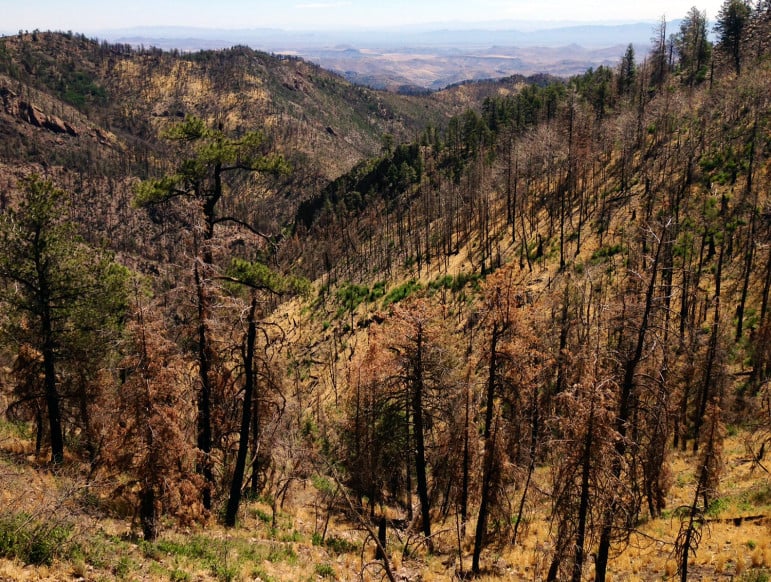
Heath Haussamen / New Mexico In Depth
Though there’s some new growth a year after the Silver Fire on the U.S. Forest Service trail to Hillsboro Peak, new pines aren’t sprouting in many areas where old ones were incinerated.It’s not a question of if New Mexico will lose coniferous forests. Up to 18 percent of the Southwest’s forests were lost to wildfire and bark beetle outbreaks – both issues related to the warming climate – between 1984 and 2006, according to a 2010 study Allen helped author.
The question is how many coniferous trees New Mexico is going to lose.
Timber overgrowth and ocean weather patterns make the Southwest one of the first regions where the effects of climate change have become observable. With models predicting that the Earth’s temperature will continue to rise during this century, some scientists say the transformation of the Southwest’s forests could foretell what’s in store across the globe for trees – which filter our air, absorb carbon dioxide, and produce oxygen for humans.
Pines and other coniferous trees exemplify the American wilderness and are culturally significant in New Mexico – it’s why the piñon is the state tree. Depending on how significant the loss ends up being, Allen says it could affect the functioning of watersheds – areas where water runs into streams and rivers – and carbon sequestration – the process of trees capturing and storing carbon dioxide from the atmosphere. It could affect wildlife habitats.
There could also be societal effects in areas such as recreation and hunting, and other impacts on communities that are situated in changing forests.
Getting away from ‘that Smokey Bear mentality’
There’s no disputing that America’s forests are unnaturally overgrown. Cattle grazing in the 19th Century reduced the grasses that helped fires spread. And for decades starting in 1910, federal government policy dictated exterminating all wildfires.

Heath Haussamen / New Mexico In Depth
Before the Silver Fire, areas in the Black Range including the U.S. Forest Service trail to Sawyer’s Peak, shown here in 2010, were overgrown due to decades of fire suppression by humans.Today, scientists understand wildfire as a natural process that thins trees and keeps forests healthy. Because of human intervention, coniferous forests across the Southwest are denser and more overgrown than in the past.
If overgrowth and drought were the only factors in the current coniferous die-off, the Southwest’s forests might return to a more natural state. But rising temperatures could make the tree die-off even more extreme.
For example, the warming climate has intensified the damage done to trees by bark beetles, which survive milder winters in greater numbers. That means more dead, dry trees ready to burn.
Warmer temperatures also make for drier conditions. Warmer air holds more water, effectively sucking it out of trees and the ground. Scientists predict the Earth’s temperature will continue to rise during this century and beyond.
All of that means we’ll continue to see blazes like the 2013 Silver Fire in forests across New Mexico and the Southwest. That’s not necessarily bad, according to Doug Cram.
Cram focuses on studying how fire is impacting forests, rangelands and riverbanks. The extension fire specialist at New Mexico State University is skeptical that more of New Mexico’s mountain ranges will look like the Organs in the future. He also calls predictions of widespread tree deaths “a bit ivory tower,” saying if the Southwest experienced a dramatic increase in rain, our forests “could look like the rainforest.”
Cram’s focus isn’t on what the Southwest’s forests will look like in the future, however. He studies what’s happening today: Forests are burning, and they need to.
While “some pretty dramatic changes” are already apparent in New Mexico’s forests, he says what emerges will be “much more resilient to drought, insects and fire.” That was true of forests historically, but not in the last century or so when humans prevented fires that kept forests healthy.
“We need to get away from that Smokey Bear mentality that fire is bad,” Cram said.
The Black Range is transforming
It’s difficult to know how severe the tree die-off will be, Allen said. Models that predict the earth’s continued warming are fairly consistent. But understanding enough about how trees die to create models that more consistently predict the future is tricky: Many factors affect the death of a single tree, let alone an entire forest.
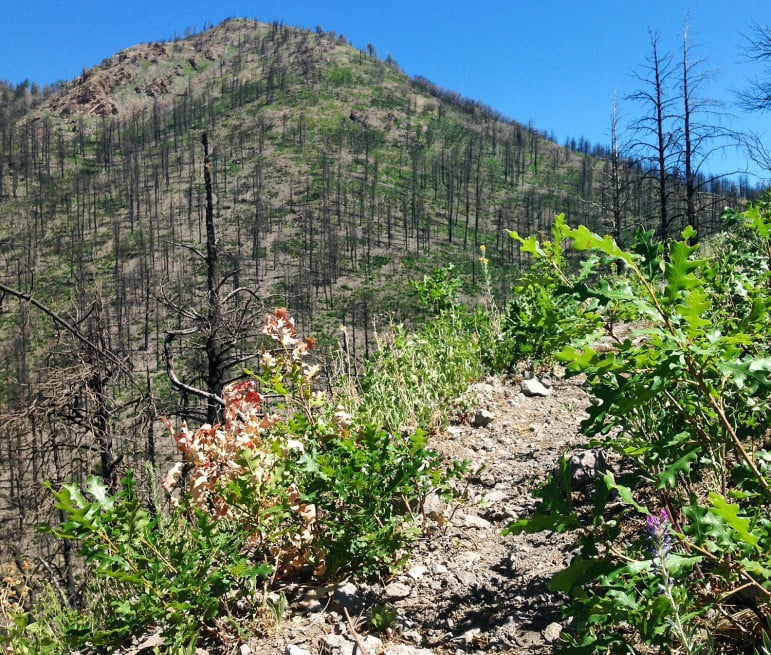
Heath Haussamen / New Mexico In Depth
Gambel Oak is sprouting on many slopes where ponderosa pines and other trees burned in last year’s Silver Fire.Allen says the Black Range “could look like the Organs by the middle of the century.” In the Black Range, a rocky landscape where yuccas have been growing alongside coniferous trees, a shift is already apparent.
Heading north from Emory Pass along a Forest Service trail to the 10,000-foot Hillsboro Peak, it’s easy to envision a future landscape dominated by Gambel oak shrubs and tall aspens. That’s because they’re sprouting in greater numbers than existed before the fire.
Unlike pines, Gambel oaks have vast underground root systems that can stretch for miles and sprout multiple plants over wide areas. Many aspens also grow from a single root system. Those species often survive fires coniferous trees don’t.
In the Black Range District, which includes part of the Silver Fire burn scar, there are no plans to reseed with new ponderosa pines, said Larry Cosper, the Forest Service’s district ranger for that area. “It’s really too dry here to plant trees with any success,” he said.
‘It’s like it’s a different world’
Forests are changing in Northern New Mexico, too. A bark-beetle infestation a decade ago decimated some pine forests throughout the region. Along the Interstate 25 corridor north of Santa Fe, lands formerly dominated by piñon are today primarily covered in juniper and grass.
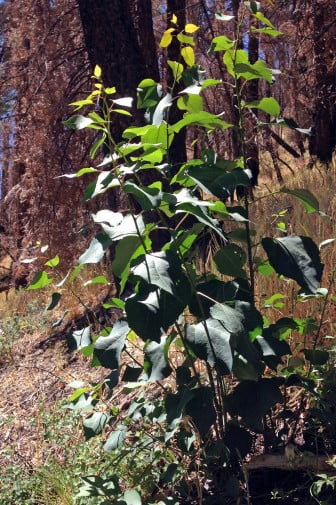
Heath Haussamen / New Mexico In Depth
Aspens are also sprouting in the burned area along the U.S. Forest Service trail to Hillsboro Peak.Then there’s the shift in the Jemez Mountains in the Santa Fe National Forest near Los Alamos. From his office at Bandelier National Monument, Allen has watched and studied a number of fires including 2011’s Las Conchas blaze that burned hot and fast across more than 156,000 acres.
Some areas have seen a “fair amount of recovery” since that fire, he said – aspens and oaks growing in middle and upper elevations. But a look across the lower-elevation Dome Wilderness near Bandelier, Allen said, shows how high-severity fires kill everything, including seeds buried in the ground. Much of that wilderness area burned in the Dome Fire of 1996 and was again decimated in the Las Conchas blaze three years ago.
“There’s a 30,000-acre hole in what used to be forest and woodland where there’s literally not a live conifer,” Allen said of that area. “And it looks like desert mountains. It’s like it’s a different world.”
Those changes illustrate a historic shift. Tree-ring records reveal two mega-droughts in the last 1,000 years – one in the late 1200s and another in the late 1500s. The first drought likely played a significant role in the migration of pre-Puebloan Native Americans to areas along the Rio Grande. The drought in the 1500s, which wasn’t as severe, may have killed a significant percentage of the Southwest’s trees.
The current drought is already as severe as the drought of the 1500s. A 2012 study Allen helped author projected that, based on climate projection models, by 2050 the current drought will be far worse than any in the last 1,000 years.
The study’s results predict the transition of many forests worldwide, including those in the Southwestern United States, to landscapes “unfamiliar to modern civilization.”
‘A harbinger’ for the rest of the planet?
To help in places where society values saving trees, a 2013 study Allen helped author suggested a shift in water management priorities might be necessary. Instead of focusing only on downstream uses of water for agriculture and cities, the study suggests irrigating forests. Tree thinning, mulching and planting drought-tolerant vegetation are other suggestions for aiding forests during this transition.
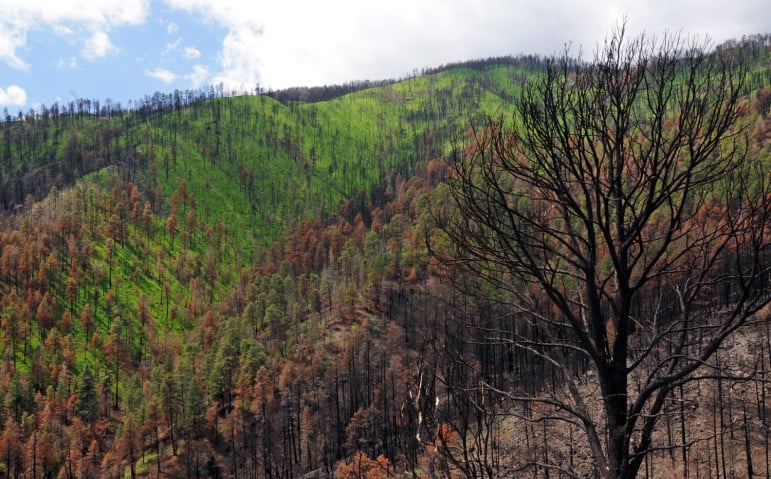
Heath Haussamen / New Mexico In Depth
Commercial barley seed was dropped after the Silver Fire to reduce erosion. The plants created deep green landscapes on some slopes along Highway 152 last fall. That was the only real intervention before or after the fire. One study suggests greater intervention to save some forest areas – possibly including irrigating forests, tree thinning, mulching and planting drought-tolerant vegetation.Such efforts may require “a radical rethinking” of water management, the study states. But it will be important to view forest areas not only for the water they can provide humans, but also as watersheds with trees worth saving.
That doesn’t address the larger issue of climate change. If humans don’t “get serious” about curbing greenhouse gas emissions that are warming the planet’s atmosphere, Allen says climate change will have serious consequences far beyond the Southwestern United States.
Trees breathe through pores in their leaves. During droughts, they sometimes close the pores to hold in the water they have. A 2012 study of 226 tree species from 81 sites worldwide found that 70 percent leave their pores open during droughts until they’re close to distress. That’s probably because trees, which compete against each other for sun and other resources, are trying to maximize growth, Allen said.
So a temperature increase of a few degrees can have a dramatic impact on trees across the globe. Conifer die-offs like the Southwest’s are also already occurring in Western Canada.
“Trees everywhere are vulnerable,” Allen said. “It doesn’t take as severe a drought in the Amazon as it does here to kill a tree.”
It’s difficult to imagine that today’s forests can survive in places like the desert Southwest, Allen said.
“We may be kind of a harbinger of what will happen elsewhere,” he said.
The bizarre, unscientific and dismissive comments of Doug Cram do not belong in this article. First, without considering predictions, scientists have been documenting the very real and massive decline in USA Southwestern forests over the past several decades. [A new U.S. Forest Service assessment shows tree mortality in New Mexico exceeding regrowth by a factor of more than three to one, for example.] Second, the evidence for the possibility of the USA Southwest transitioning to a “rain forest” climate is shockingly absent in the scientific literature. If the USA Southwest began getting, say, 100 inches per year of average annual rainfall starting in 2014 and continuing, we might see “rain forest” conditions develop far in the distant future.
In assessing the absurdity of his comment, the author should ask Doug Cram about ice, for example. if the Southwest experienced a dramatic increase in ice, our landscape could look like Greenland.
NMID says it values: “Critical Thinking:. We value reporting that analyzes the claims being made, the facts, and the circumstances to present a more realistic and complete picture of what’s happening. Journalists must be wiling to dig deep to understand people, systems and issues.”
Publishing a false “balance” between science and nonsense is not the way to get at a “…realistic and complete picture of what’s happening.”
This is an excellent article on the ecological changes in our forests in the Southwest. The public including some of our blabbermouth and unscientific politicians should read this important article.